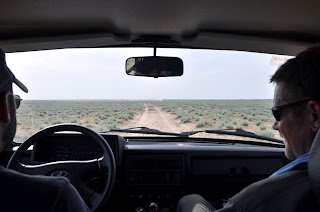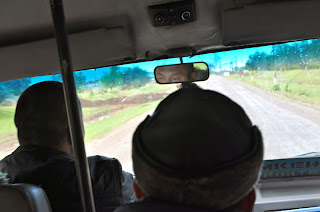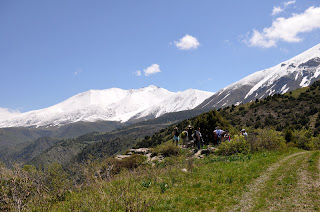Working a 6 day week was definitely worth having a 3-day weekend. Tuesday was a national holiday so everyone worked Saturday to have Sunday - Tuesday off. Spring was in full swing and a number of our husbands were off on school excursions with students. It was a perfect recipe for a ladies weekend. So, 11 teachers planned a weekend train trip to the Aksu-Zhabagly Nature Reserve in southern Kazakhstan.
Our old soviet train at the Almaty train station.
These ladies know how to travel. There was more food than we could have ever eaten for our 12 hour train ride.
Our guide met us at the train station at 5 a.m. and we drove 20 minutes to the guesthouse. After dropping our stuff in our rooms, we sat down for breakfast at this immaculate and well-supplied table.
All morning it rained, and poured, and rained and poured. We all admitted there was joy in relaxing indoors and away from work. Even so, I didn't want to take a 12-hour train ride to be stuck indoors. So, as soon as there was a break in the rain, we threw on shoes and went for a walk.
Zhabagly is at the foot of the reserve, so we didn't have to walk far to get away from town.
We spotted a shepherd holding steady in the rain and headed for him.
The mist moved by the minute.
He had a big smile for us and posed happily for photos. Here he is with our guide, Ruslan on the left.
This picture is a bit blurry because as soon as we reached the shepherd big, fat drops began to fall once again. We hurried back to the guesthouse, but all of us were wet to the skin by the time we reached it. We had hoped to travel to a neighboring village that afternoon to watch kokpar, or goatball, as we dubbed it, but the rain didn't seem to be clearing. The ladies napped, read, played cards and chatted. The guesthouse was so comfortable and the service was fantastic. We were very happy to have a lazy day. Before lunch, Ruslan told us goatball had been canceled. He said maybe it would be rescheduled for the next day, but we had planned to hike in the reserve that day. We were all disappointed. A few hours after lunch, the rain had stopped and the clouds began to clear. Ruslan came to us and said goatball was on!
In the van on the way to goatball.
Now, you may be asking yourself, "What exactly is goatball?" Well, if Kazakhstan had a national sport, this just might be it. It is generally played by neighboring villages from early spring through the end of spring only. A goat is killed, gutted, and most of the meat is removed. That meat is given to a family in one of the villages. The carcass of the goat is decapitated and filled with 25 kilos of salt. Villagers bring their horses to the playing field and essentially duke it out over the carcass. It seemed that once the carcass is commandeered, the horseman sprints to the far end of the field, and on his way back drops the carcass in the middle somewhere, and the whole thing starts again. It seemed there was no ref and no tally of points.
This appears to be the proper carrying technique, the "right leg tuck".
Fighting for the carcass.
The goat has been dropped and the players close in.
As Spiderman clings to a wall, these guys cling to their horses.
Notice the posture of the riders, they are nearly off their horses wrestling for the goat.
Although the field was big and wide, the fury of wrestling took the mob of horses into the trees and spectators. More than once we had to jump to the side because of oncoming horses.
After a while, the players began to show off. This guy galloped right past us...
...and flung the goat nearly at our feet.
See the boot and hand on the saddle? Then see the other hand grabbing the goat on the ground? Amazing.
The snatch!
The first rider has the goat and is sprinting for the far end of the field.
A player greets a spectator.
This guy also loved to show off. He'd ride right in front of us, goat in the right-leg-tuck, and scream "Almaty!".
They even let us get on their horses!
The drop signaling another round.
All the players carried their whip in their mouth.
Trying to get the saddle straight after the snatch.
See the object at the top of the frame? That is a leg that was ripped from the goat and is being tossed into the crowd the foreign woman. These guys know to get the crowd riled up!
A spectator.
Not sure what this guy was doing here...victory dance?
Check out his helmet.
They were more than happy to pose for photos with a group of 11 foreign women.
This guy pointed at me, grunted, and waved me over.
After the photo, he let me get on his horse! Kazakhs love to let foreigners sit on their horses.
The little guy in front already knew how to ride, leading his horse around the field after the game.
Across the road from the field was this beautiful hillside, covered in yellow wild rose and pink foxtail lilies.
A post-kokpar get together in the village.
Looks like Idaho.
On the way back through one of the villages, a few of us got out and walked through town. It was a beautiful afternoon after the rain and many people were setting near the road, obliging portraits.
Look at those mountains in the distance!
At first it was just the girl on the trike and her dad. Observe the children in the background, running towards us!
Then there were a few more...
...until it ended with this! The whole family (maybe two families?)
Local posse.
With each new house more and more vibrant people came out to greet us. We speak little Russian, and they speak little Russian (mostly Kazakh), but they were so kind and welcoming.
There was a spring every hundred meters or so spurting fresh snowmelt.
This babushka is 82. She was a bit camera shy at first, but eventually came around.
This man was great! He gathered all these boys around for the photo.
He had us laughing with his poses.
Just after this photo he pulled his son's pants down to proudly display his parts. Surprisingly, it's the only thing that got the little guy to smile.
Then he wanted his photo taken with Judy.
Crossing the tracks to the next town.
Judy shares her portrait.
She had fantastic jewelry!
Upon returning to our guest house, the road was crowded with cows. The village has a system worked out where each morning families bring their sheep and cows out to the road. The herder comes through town collecting the animals and takes them out to pasture during the day. At night, he brings them back through town and families again collect their animals for the evening until the next day.
The next morning brought beautiful clear skies and fantastic views of the mountains.
The shepherd had just collected the sheep and was on his way out of town. Toni and I tried to catch up. We didn't get to the shepherd, but we did get these precious shots of a little guy trailing behind the herd.
Not a bad place to make a home.
Then we saw the "schoolbus" coming into town. A grandpa was dropping his granddaughter off for school in town.
She spoke a little bit of english and told us her name, how old she is, etc. She was beautiful.
After breakfast the ladies load onto the bus to go to the reserve.
Our driver.
Ruslan on the patio of the Mountain House, literally at the gates of the reserve.
Ruslan with his wife and 3 month old daughter, Elvira in the Mountain House dining room.
Entering the reserve.
The Aksu-Zhabagly Reserve is named for the two rivers that flow through it. It is the oldest reserve in Kazakhstan, established 1926, and the largest in Central Asia.
A ranger in the park. Visitors may only enter with a registered guide.
And our luck! Not only was it a gorgeous day, but there were wild tulips!
White foxtail lilies.
Maybe one is 50 tulips was yellow with the red stripe.
It is believed that tulips originated in these mountains. They were first carried to Turkey via the Silk Road, then later to Holland where they were cultivated and crossbred. Every tulip today came from these two varieties that grow wild here.
The delicate Kaufman variety.
The vibrant red variety are called Greggs.
The trail we hiked (one of 6 established trails in the reserve) took us up and up until we were on the rim of this canyon with towering snow-covered mountains on the horizon.
A rest stop along the trail.
At our lunch spot, our guide jumped on his horse (that the ranger had been using) to show off a bit.
Galloping with no hands, feet out of the stirrups.
There was a German scientist staying in the reserve studying the Tien Shan bear. He said there are plenty around, that they would be moving up the mountain due to the warmth. We looked and looked through our field goggles, but didn't spot one. Next time.
A falls slowly cutting through canyon walls.
There are also ibex in the reserve. Our guide said that in May the ibex come to these canyon walls to deliver their kids. He said last year he counted 30 ibex with kids on this rock face alone.
Tiny wild iris.
Our guide also said that two weeks ago there were 3 times as many tulips, and the following weekend they'd be all gone.
On the way back down.
Looking towards the valley and towards town.
Our guide, Ruslem, was very excited to guide us. He said he's never guided a group of all women.
After a shower, packing and dinner, it was time to get back on the train.
This woman has jars of yogurt or maybe sour cream to sell to passengers.
Selling fresh bread and fragrant flowers. The woman selling flowers posed coyly for a portrait (that sadly was very dark) and then handed me a bouquet for the train ride home.


































































































































































































